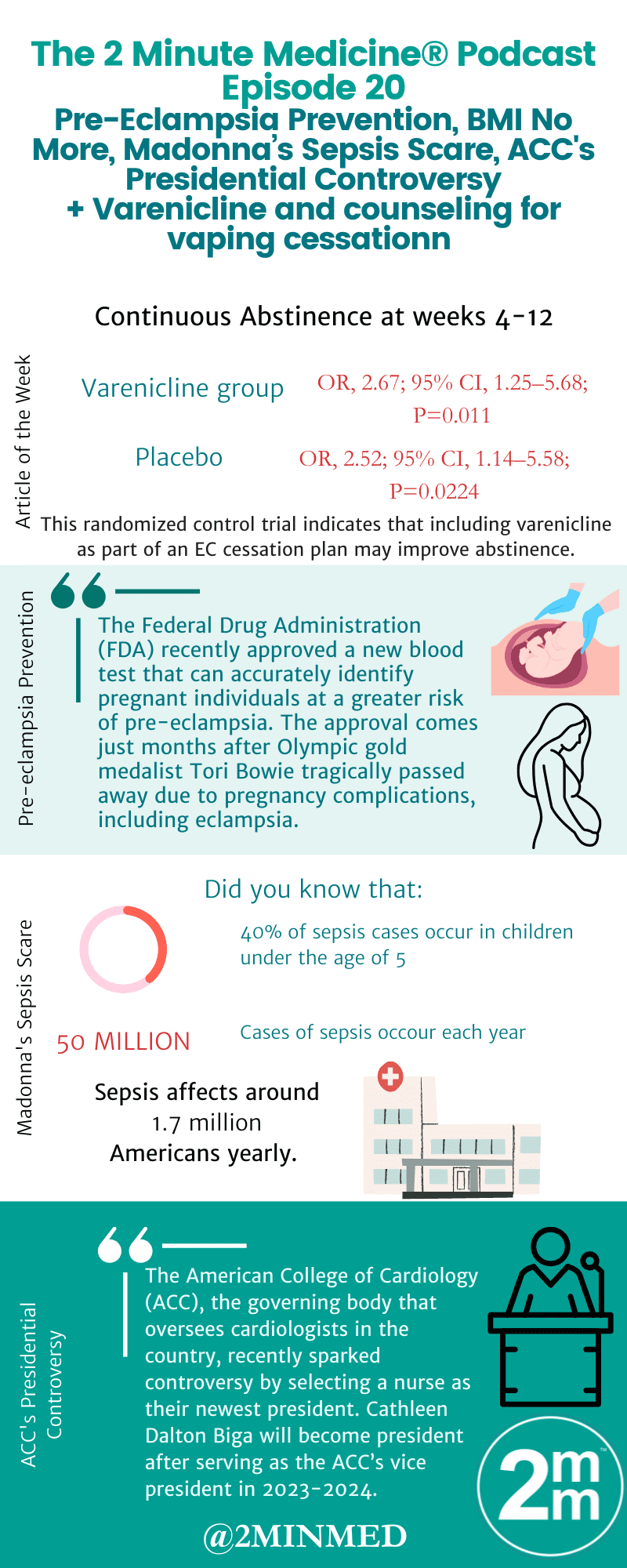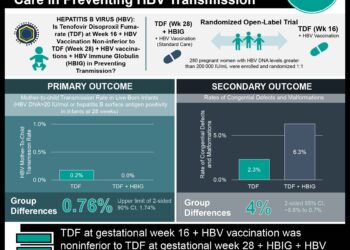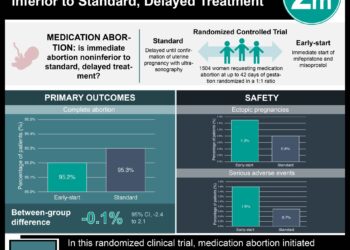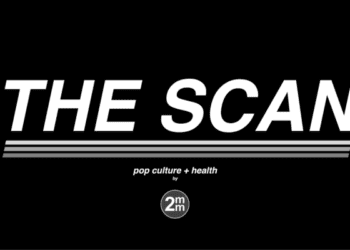The 2 Minute Medicine Podcast Episode 20
July 27th 2023
Welcome to the 2 Minute Medicine Podcast, summarizing the latest medical studies, curated and written by practicing physicians. On this podcast, twice a month, we cover the latest in healthcare news and research evidence.
Our episode is live!
Episode Description
We begin this episode by discussing our article of the week from BMC medicine, “Varenicline and counseling for vaping cessation: a double-blind, randomized, parallel-group, placebo-controlled trial”. In the second half of our episode, we begin with a discussion about a blood test that was recently approved by the federal drug administration that can detect those at a greater risk for pre-eclampsia. Then we discuss the American Medical Association’s new policy regarding the use of BMI in medical practice. Finally, we end with a conversation about Madonna’s recent sepsis scare, as well as some of the injuries seen in the latest edition of the Tour de France.
Click here to listen to this episode on Apple podcast
Click here to listen to this episode on Spotify
 Transcript
Transcript
[Deepti] Welcome to the 2 Minute Medicine Podcast, summarizing the latest medical studies, curated and written by practicing physicians.
For our full suite of daily medical study summaries and updates written by practicing doctors, please visit our website at 2minutemedicine.com to start reading new daily content right now, for free. On this podcast, twice a month, we cover the latest in health care news and research evidence. We are your hosts Deepti and Andrew. On today’s episode, we’ll start off by discussing our two articles of the week. In the second half of the episode, we will look at health issues that have arisen in popular media.
[Andrew] Our article of the week comes from BMC medicine and is titled “Varenicline and counseling for vaping cessation: a double-blind, randomized, parallel-group, placebo-controlled trial” There are currently no evidence-based recommendations to guide e-cigarette (EC) cessation. Given that EC use is increasing worldwide, the number of patients turning to clinicians for guidance on cessation is likely to increase. Researchers aimed to evaluate the effectiveness of varenicline for EC cessation. 140 participants interested in EC cessation were randomized into two groups. One group received 1 mg varenicline twice per week for 12 weeks, in addition to counseling. The second group received a placebo treatment twice weekly for 12 weeks, in addition to counseling. Participants were followed for an additional 12 weeks after the end of treatment. The primary study endpoint was abstinence from weeks 4-12. They also assessed continued abstinence during the follow-up period. Continuous abstinence was significantly higher in the vareniclinegroup compared to placebo at weeks 4-12 (OR, 2.67; 95% CI, 1.25–5.68; P=0.011) and weeks 4-24 (O,R,2.52; 95% CI, 1.14–5.58; P=0.0224). This randomized control trial indicates that including varenicline as part of an EC cessation plan may improve abstinence. This study may be helpful to guide clinicians counseling patients on EC cessation. Limitations of the study include the small sample size and short follow-up period. Future research may assess whether varenicline is beneficial for long-term EC cessation. It also remains to be determined whether varenicline alone, without counseling, is beneficial for EC cessation. Nonetheless, study results may reflect a novel research field investigating viable evidence-based recommendations for e-cigarette smoking cessation.
[Andrew] Now for The Scan.
The Story: The Federal Drug Administration (FDA) recently approved a new blood test that can accurately identify pregnant individuals at a greater risk of pre-eclampsia. The approval comes just months after Olympic gold medalist Tori Bowie tragically passed away due to pregnancy complications, including eclampsia. Many hope that the new blood test will reduce the number of fatalities attributable to pre-eclampsia and aid in reducing racial disparities seen in birth complications.
You might be wondering, what is pre-eclampsia?
[Deepti] Great question. Pre-eclampsia is a pregnancy complication involving high blood pressure, increased urine protein content, and sometimes kidney damage. Eclampsia results from pre-eclampsia and is a more severe form of the condition that is accompanied by seizures or coma. The exact cause of pre-eclampsia is unknown, but it is suspected to be associated with abnormalities of the placenta. Medications to lower blood pressure and reduce seizures can help manage these conditions. However, the only way to cure the spike in blood pressure is to deliver the baby; as a result, pre-eclampsia can result in preterm delivery. The condition can also result in several other complications, including organ failure, fetal growth restriction, and death in severe cases. Early detection of pre-eclampsia and those at risk can allow for preventative therapy, such as daily aspirin, to minimize the risk of devastating complications.
[Andrew] The good news is that pre-eclampsia is not very common — only about 4% of pregnancies in the United States are affected by the condition, and the more severe form, eclampsia, is even less common. Some well-known risk factors for the condition include having higher blood pressure at baseline, type 1 or 2 diabetes, kidney disease, and autoimmune disorders. Certain pregnancy characteristics can also place people at higher risk, including having advanced maternal age, being pregnant with more than one child, or having experienced pre-eclampsia in a previous pregnancy. The bad news is that despite its relatively low prevalence, pre-eclampsia is the leading cause of many poor outcomes in childbirth, including maternal death, intensive care admissions, and prematurity. The burden of disease is not distributed evenly, as the rate of pre-eclampsia is around 60% higher in black women than in white women. This is just one pregnancy complication among many that black women are disproportionately affected by. Beyoncé and Serena Williams are two prominent figures who have brought attention to this issue by discussing their experiences with birthing complications. Addressing the social determinants of health, early detection, and recognizing those at greater risk are ways to reduce the racial disparities seen in pre-eclampsia rates and outcomes. Many hope the new FDA-approved blood test will play a role in this.
Next, next take a look at how the American Medical Association (AMA) recently adopted a new policy indicating that BMI should no longer be used in isolation to determine whether a patient is at a healthy weight due to limitations of the measurement.
[Deepti] The longstanding use of BMI in medicine has not been without its controversies. For starters, the weight measurement does not distinguish between fat and muscle. As a result, elite athletes with very muscular builds, such as LeBron James, Tom Brady, and Lionel Messi, are classified as overweight based on BMI measurements, despite being extremely fit and having a low body fat percentage. BMI is also a poor predictor of health, as previous studies have shown that the measurement does not correlate well with other markers of metabolic health, such as blood pressure and cholesterol levels. Celebrities such as Lizzo have brought attention to the fact that weight is not a perfect predictor of health outcomes and that exercising and eating well can have health benefits, even if it doesn’t result in a significant drop in BMI.
Another critical limitation of BMI is that it does not account for differences across races, sexes, and ages, making it an even worse predictor of health for specific groups. This is because the “average” values used for BMI classifications were based on predominantly white populations. In some instances, BMI cut-offs are used to determine insurance reimbursement for certain medications and surgeries, leading to unfair exclusion of those whose health is not accurately represented by the measurement.
[Andrew] Absolutely. The AMA’s BMI policy encourages physicians and insurance companies to no longer consider BMI in isolation but instead include other indicators of health, including visceral fat, waist circumference, and various metabolic factors, when making determinations about peoples’ health.
Next, as you may have heard, Madonna is back on the mend after a stay in the intensive care unit. Earlier this year, the singer postponed the dates of her “Celebration Tour” due to a bacterial infection that led to sepsis. The pop star has provided an update on her current situation, indicating that she is doing better and focusing on her health before resuming the tour.
Sepsis is an inappropriate and life-threatening immune response to an infection. Typically, an infection spurs the immune system into action, targeting and clearing the offending pathogen. In sepsis, this process goes into overdrive, triggering a full-body inflammatory response that damages your own tissues and can have severe consequences. In some instances, sepsis can progress to septic shock, when a person’s blood pressure drops dangerously low due to the dysregulated immune response. The management of sepsis includes the administration of antibiotics, intravenous fluids, and medications to increase blood pressure back to a normal level. Sepsis affects around 1.7 million Americans yearly. Some people are at an increased risk of developing the condition, including those over 65 or under the age of 1 and those with a weakened immune system or chronic medical conditions. Sepsis can also result from a viral infection and following extended hospital stays, so there has been a strong link between COVID-19 hospitalizations and sepsis cases.
[Deepti] Just to add to this, even with treatment, many sepsis survivors experience long-term symptoms such as fatigue, swelling, repeat infections, memory loss, and more — largely considered “post-sepsis syndrome.” As in Madonna’s case, quick treatment is the best way to prevent long-term complications of the condition.
Last but not least, let’s take a closer look at injuries of the tour de france. The Tour de France recently came to a close, and although this year’s 110th edition of the cycling event was full of heroic performances, it wasn’t without its disappointments. On the 8th day of the 21-stage event, one of the event’s most winningest athletes, Mark Cavendish, had to drop out of his last Tour after suffering a broken collar bone following a crash. Unfortunately, Tour-ending injuries are relatively common.
A broken clavicle, often called the collarbone, is the most common injury in Tour de France athletes. The clavicle is the bone that connects the sternum to the shoulder, so these fractures often occur in riders after falling on a shoulder or outstretched hand. Treatment usually requires wearing a sling and occasionally can require surgery, including placing a plate or screw in the bone.
[Andrew] In fact, Mark Cavendish previously had surgery for a broken collarbone back in the 2017 Tour de France. Other common fractures experienced by cyclists include those in the wrist, hand, femur, upper arm, and ribs.
In addition to fractures, head injuries are another common complication seen following cycling crashes. Fabio Jakobsenwas another athlete forced to leave this year’s event, which comes just three years after the prolific sprinter experienced a life-threatening crash that left him in a medically-induced coma and kept him from cycling for eight months. The crash left him with a brain contusion, a fractured skull, and several other injuries. Fortunately, wearing a helmet can reduce the risk of head injury by over 50%. Each year the Tour is a reminder of the importance of safe cycling practices and helmet use.
We’d like to acknowledge the following members of our team for their contributions to this week’s episode
- Rhianna Davis
- Alex Chan
- Ashley Jackson
Thank you for joining us today for this episode of the 2 Minute Medicine Podcast. New episodes come out every other week and all of our content has been curated and written by practicing physicians.
Please head to our website at 2minutemedicine.com to learn more and to access all of our content including medical study summaries, visual abstracts, excerpts from our Classics book series which is available on Amazon, and The Scan, which is our medical newsletter.
Thank you so much once again. To make sure that you don’t miss any of our content please subscribe and follow us on Twitter or Instagram @2MinMed
©2023 2 Minute Medicine, Inc. All rights reserved. No works may be reproduced without expressed written consent from 2 Minute Medicine, Inc. Inquire about licensing here. No article should be construed as medical advice and is not intended as such by the authors or by 2 Minute Medicine, Inc.








